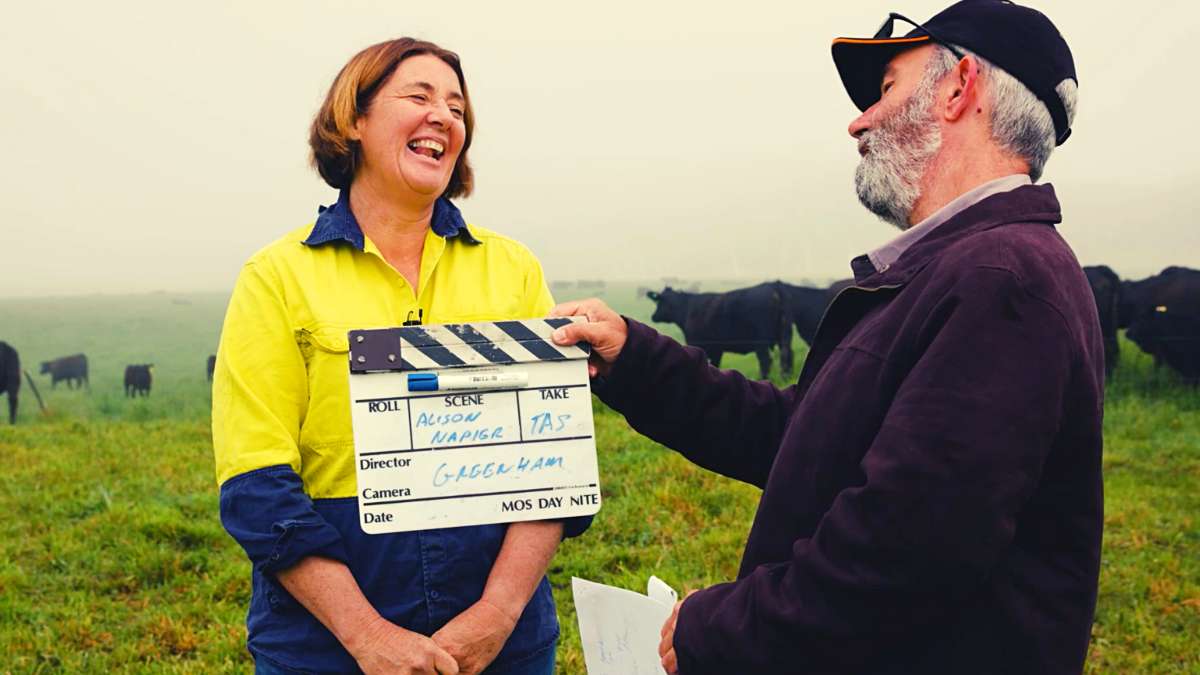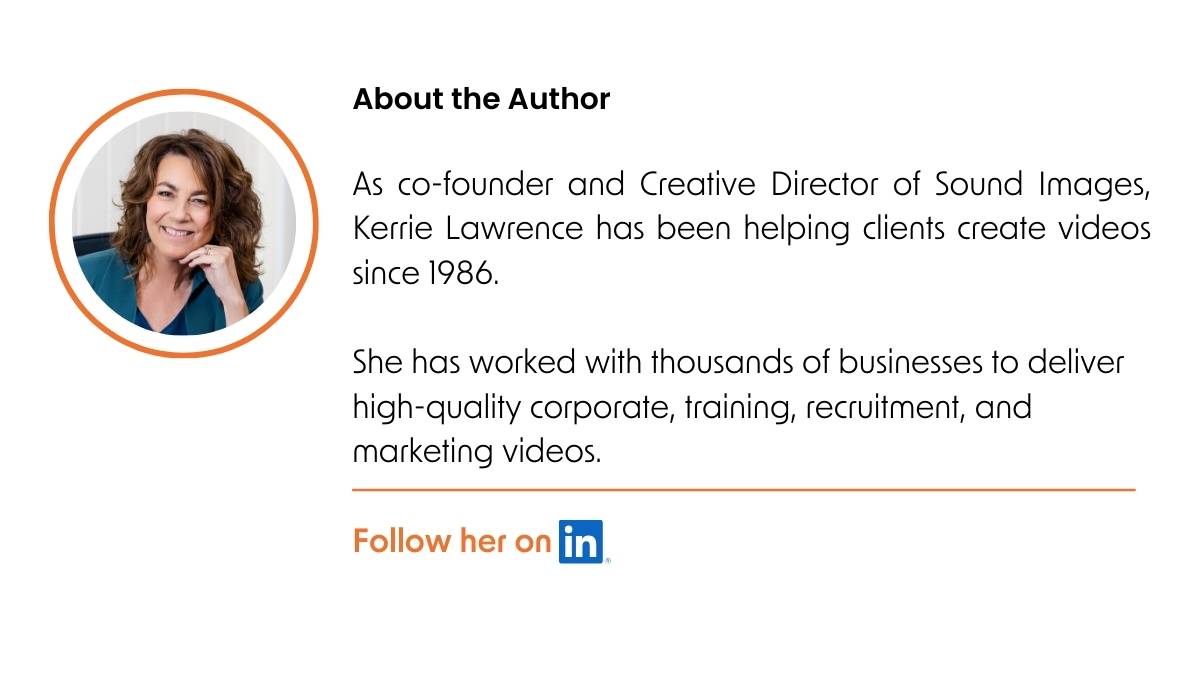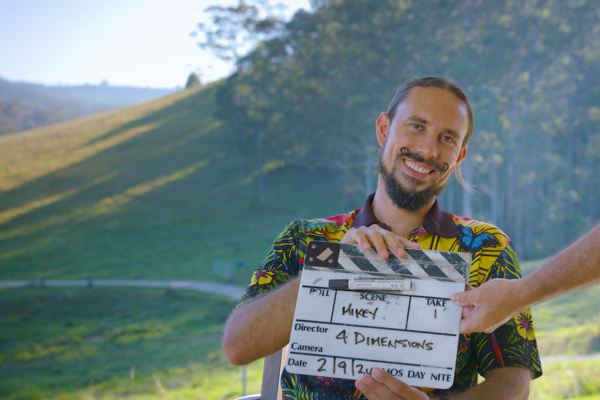How to ask clients & staff to be interviewed for your video
Introduction
A client recently asked how to approach customers for a corporate video interview.
You might have this question too.
Get it right, and you make people feel valued, not put on the spot. You give them the confidence to say yes — and show up as their best selves on the day.
So if you’re planning a corporate interview video and wondering who to ask, how to ask, and what to say, this guide is for you.
Why corporate interview videos matter

Corporate interview videos are real people sharing real stories. That authenticity is what makes them powerful.
The benefits stack up.
They build trust, strengthen relationships, and create an emotional connection.
They raise brand awareness, drive engagement, and support your wider marketing strategy.
The purpose is different for every business.
Whether it’s showcasing a client success story, a product testimonial, or giving employees a voice, the rationale is the same – audiences believe people more than brands.
Understanding why people avoid cameras

Whether it’s a customer testimonial, an employee branding piece, or a company training video, authentic on-camera interviews add the credibility and emotional connection that drives engagement.
The challenge? Getting people to agree to step in front of the camera.
Even experienced professionals can hesitate when asked to appear on a video that colleagues, clients or prospects might see.
So before approaching potential interview subjects, it helps to understand the common reasons people say no:
Fear of public exposure
For many people, appearing on camera triggers the same anxiety as public speaking – one of our most common fears.
This isn’t vanity; it’s a deep social anxiety about being judged.
So keep in mind that roughly 75% of people experience some degree of nervousness about being recorded.
Your job is to put interviewees at ease.
Uncertainty about performance
Many potential interviewees worry they’ll “mess up” or say something wrong.
Without on-camera experience, they lack confidence in their ability to clearly articulate thoughts when under pressure.
Concerns about time
Professionals are protective of their schedules.
The thought that a video shoot will consume hours of preparation and filming can be a major deterrent, particularly for executives and client-facing staff.
Fear of misrepresentation
Interviewees often worry about how their words will be edited or whether comments might be taken out of context, potentially affecting their professional reputation.
How to choose the right people for your interviews
The right interviewee — someone who speaks with heart — can transform your video.
Whether they’re a team member, a leader, or a client, their voice brings credibility.
And makes your story more engaging.
Don’t default to seniority.
Leadership voices are valuable, but some of the most powerful interviews come from someone less polished.
That natural, unscripted feel is what makes it relatable.
Aim for a mix of voices.
If it’s a recruitment video, include employees who match the roles you want to fill.
For company stories, include a cross-section of leadership and employee roles.
For a product testimonial or customer testimonial, think about who’s seen the difference your service makes at ground level, not just the decision-maker.
Rather than randomly selecting video interviewees, develop criteria for what makes someone a good fit:
- Subject matter expertise
- Personality and communication style
- Representation of diversity within your organisation
- Comfort level with public-facing roles
- Authenticity and credibility with the target audience
- People comfortable being themselves
You want people who can speak with warmth and clarity
- That might be someone on the tools
- Or someone in a client-facing role
- Or someone who’s lived the story you’re trying to tell
For client interviews, also consider:
- Length and depth of the relationship
- Success stories they can share
- Alignment with your ideal customer profile
- Prior indications of satisfaction (positive feedback, referrals)
For more guidance on how to get the best from your interviews, take a look at our tips for nailing corporate video interviews.
Ask for the interview the right way
How you ask for a corporate video interview is as important as what you’re asking. The initial request sets the tone for the entire experience.
Send a vague invite and you’ll get silence.
Send an invite that answers questions before they ask, and more people will say ‘yes, count me in.’
Framing the request effectively
Uncertainty is the biggest source of nerves — take that away, and you’ll get a more confident interviewee.
To brief the interviewee:
- Tell them exactly how the day will run.
- When and where they’ll be needed
- How much of their time is needed
- Who will be there
- What to wear
As part of this brief, you could also share a short questionnaire guideline to help them feel prepared.
When crafting your request:
- Lead with the why: “We’re creating a video to showcase our customer success stories and your experience implementing our solution represents exactly the kind of transformation we want to highlight.”
- Acknowledge the value of their time: “I understand your schedule is packed, so we’ve designed our interview process to take no more than 45 minutes of your time, plus a brief prep call the week before.”
- Explain the genuine need: “Your perspective as a front-line manager offers insights that executives don’t have, which is why we’ve sought you out for an expert interview.”
- Highlight the personal benefit: “This customer testimonial video will be featured on our company website and LinkedIn page, giving you visibility with industry leaders and highlighting your team’s innovative approach.”
Do your homework and create an information pack
Develop materials that answer questions before they’re asked:
- One-page project overview
- Interview topics and sample interview questions will set the tone
- Time commitment breakdown
- Location, what to wear and logistical details
- A summary of the audio and camera setup so there are no surprises
- Information about how footage will be used
- Examples of similar videos you’ve produced, if you have them
- A consent release form should summarise usage rights early to remove surprises and speed up legal approvals
Having these materials ready demonstrates professionalism and shows you value their time.
Reduce pressure and cover legals with consent forms
Calm the nerves by showing you’ve got a plan that protects them.
People need to know what will happen with their interview, and for employees, they need to understand they can say no without penalty.
Timing considerations
Being strategic about when you make your request reinforces your professional tone:
- Avoid high-stress periods (end of quarter or financial year, major product launches)
- For clients, consider the relationship cycle – don’t ask immediately after signing or during contract renewal
- Allow ample lead time – ideally 3-4 weeks for employees and 4-6 weeks for clients
How to approach the clients you want to interview
This is all about respect and relationships.
If you have a warm relationship with the client, you’ll have more success when you start with a phone call — not an email.
- A short conversation that explains what type of video you’re creating, how it’s going to be used, and why their perspective matters.
- Frame it as an expert interview or spotlight rather than a sales pitch
- Include when you’d like to film them, the location, and a quick summary of what to expect.
- Reassure them it won’t be a high-pressure environment with quickfire interview questions. Instead, it will be a relaxed chat, guided by an experienced interviewer.
Some clients may be hesitant — especially if they don’t love the spotlight.
Let them know there’s no pressure to be perfect and they’ll be supported through the process.
And that the interview is edited to remove stumbles. They’ll have plenty of time to gather their thoughts.
Once they’ve agreed in principle, follow up with an email and the information pack.
How to approach the employees you want to interview
This works best through internal comms or direct line managers. Ideally, it should come from someone they know and trust.
Position it as part of a company project, not just an ad hoc task.
Make sure they understand it’s voluntary.
Give them context about the video – is it a company culture video, a recruitment video, or to be used for employer branding?
Explain why their voice matters. It could be that they’re great at what they do, or that they’ve got a unique perspective to share.
Tell them exactly how the day will run:
- when they’ll be needed
- where they’ll be filmed
- and who will be there.
If they’re unsure, offer a quick pre-interview chat with the video team. It’s a chance to explain the process, answer any questions, and help them feel at ease before the shoot.
Uncertainty is the biggest source of nerves — take that away, and you’ll get a more confident ‘yes’ for the interview.
When in-person isn’t possible: remote interview options
Not every interview needs to happen face to face.
If travel or scheduling makes that tricky, you can still capture a professional result remotely.
Platforms like Riverside record high-quality video and audio locally on each participant’s computer, so the final footage isn’t affected by a shaky internet.
It’s a reliable option when in-person filming isn’t possible.
Sample email request templates

If you can’t directly connect with your potential interviewees via a phone call, here are email templates you can customise to make the ask clear, respectful, and pressure-free.
Sample email request template for clients
Subject: We’d love to feature your perspective on our [Service/Product video]
Hello [Name],
Your team’s success using [Our Service/Product] to [specific achievement] stands out as an example of what’s possible when [value proposition].
We’d love to feature your perspective in a corporate interview video as part of our marketing strategy.
What’s involved:
- A 30-45 minute video interview (remote or at your office, whichever you prefer)
- Sharing your experience implementing [specific feature/solution]
- Discussion of outcomes and business impact
- Professional filming with minimal disruption to your day
- Opportunity to provide feedback before publication
Benefits of participating:
- Visibility for your organisation’s innovative approach
- Recognition as a thought leader in [industry]
- Access to the final video for your own marketing/communication use
We’re looking to film during [time period] and can work entirely around your availability.
Would you be interested in exploring this opportunity?
I’ll follow up tomorrow with a quick call to discuss details and answer any questions.
Best regards,
[Your name]
Sample email request template for employees
Subject: Your expertise needed: 30-minute interview for our customer onboarding video
Hi [Name],
Your work with the [specific project/team] has been instrumental in improving our customer onboarding process, and we’d love to include your perspective in a new training video we’re creating for the sales and customer success teams.
This will support our employer branding and recruitment efforts.
What we’re looking for:
- A 30-minute filmed interview sharing your insights on [specific topics]
- Your authentic perspective on [challenges, solutions, etc.]
- No need to memorise a script – we want your genuine expertise
The video will be used to recruit new employees and internally for training team members.
It will highlight the innovative approaches your team has developed.
If you’re open to participating in this company project, we can work around your schedule during the week of [date range].
We’ll provide sample questions in advance and a brief prep call to answer any questions.
Would you be willing to share your expertise in this way?
It would make a significant difference in how we train our growing team.
Looking forward to your response,
[Your name]
Setting clear expectations

Once someone says yes, preparation and clear communication prevents surprises and builds trust.
Pre-interview email confirmation
As you approach the day of filming, send a short confirmation email covering date, time, location, arrival instructions, how long it will take, what the setup looks like, who to contact on the day, and simple wardrobe guidance.
Pre-interview phone call
Arrange a 15-minute call a day or two before filming. Walk them through the format, answer any lingering questions, and confirm logistics. It’s a small step that pays off in calmer, more confident interviews.
Helping interviewees feel comfortable and confident

The day of filming is where confidence is won or lost.
A few thoughtful steps — before, during, and after — can make the difference between stiff answers and natural, engaging stories.
Set the scene
Make the space physically comfortable: slightly cooler if there are lights.
Have supportive seating, water and tissues at hand.
Keep the room quiet and interruption-free, and allow short breaks if the session runs long.
Explain the format
Let them know the interview will be conversational, not scripted. They’re simply sharing their perspective in their own words.
Take away the pressure
Remind them this isn’t live and it’s not a test. They don’t have to get it right the first time. They can pause, reflect, or rephrase as often as needed.
Help them feel confident on camera
Many people worry about how they’ll look or sound.
Reassure them that lighting, sound, and camera angles are set up to help them look their best — and that a skilled editor will make the result polished and natural.
Ease the nerves
Spend a few minutes chatting before filming.
A couple of warm-up questions and some positive reassurance go a long way.
For very nervous interviewees, a quick walk-through or pre-chat with the crew can help them settle.
Guide with care
Encourage the interviewer to keep it relaxed and conversational.
Allow pauses, and if feedback is needed, start with what worked, give one clear adjustment, and explain why.
Follow through afterwards
Thank them sincerely and follow up within 24–48 hours with a personal note.
Let them know when the video will be ready, give them early access, and share clips they can use.
Recognition and updates turn a one-time interview into a positive, lasting experience.
Addressing common concerns proactively

Once someone expresses interest—or hesitation—be ready to address concerns directly and honestly.
Sharing examples of other corporate interview videos shows the authentic and relatable style you’re aiming for.
“I’m not good on camera”
This is perhaps the most common objection. Effective responses include:
“We work with professionals who specialise in making people comfortable on camera”
“The format is conversational—just like we’re talking now”
“We can do multiple takes if needed, and you’ll have input on the final selection”
“Authentic responses connect with viewers much more than polished performances”
Show examples of similar interviews with non-professional presenters to demonstrate the natural approach you’re taking.
“I don’t know what to say”
Alleviate content anxiety by:
Providing questions at least one week in advance
Offering a no-pressure prep call to discuss topics
Clarifying that they don’t need to memorise answers
Emphasising that you’re looking for their genuine perspective, not perfect responses
Explaining that the video will be edited to showcase their best moments
“I don’t have time for this”
Respect time concerns with concrete solutions:
Break down the exact time commitment (e.g., “15-minute prep call, 45-minute interview, 10 minutes for feedback”)
Offer to come to their location or provide remote recording options
Be flexible with scheduling, including before/after standard hours if preferred
“How will this be used?”
Transparency about usage builds trust:
Provide specific details about distribution channels
Clarify audience and estimated viewership
Define the content lifecycle (how long it will be active)
Put usage terms in writing
Offer review privileges before publication
Key takeaways
Successful corporate interview videos don’t start with the camera. They start with choosing the right people, inviting them the right way, and preparing them so there are no surprises.
- Choose the right people — voices with warmth, credibility, and authentic stories.
- Ask the right way — explain what’s involved, why their voice matters, and how their time will be respected.
- Prepare them well — provide a simple info pack, consent details, and clear logistics.
- Create comfort — set the scene, ease nerves, and remind them you expect natural, not perfect.
- Follow through — thank them, share the finished video, and make it a positive experience they’ll want to repeat.
That’s when people relax, speak with heart, and give you the authentic stories that make these videos so powerful.
Jump ahead
2. Why corporate interview videos matter
3. Understanding why people avoid cameras
4. How to choose the right people
5. Ask for the interview the right way
6. How to approach clients for an interview
7. How to approach employees for an interview
8. Sample email request templates
10. Helping interviewees feel comfortable
11. Addressing common concerns proactively
Video on your radar?






